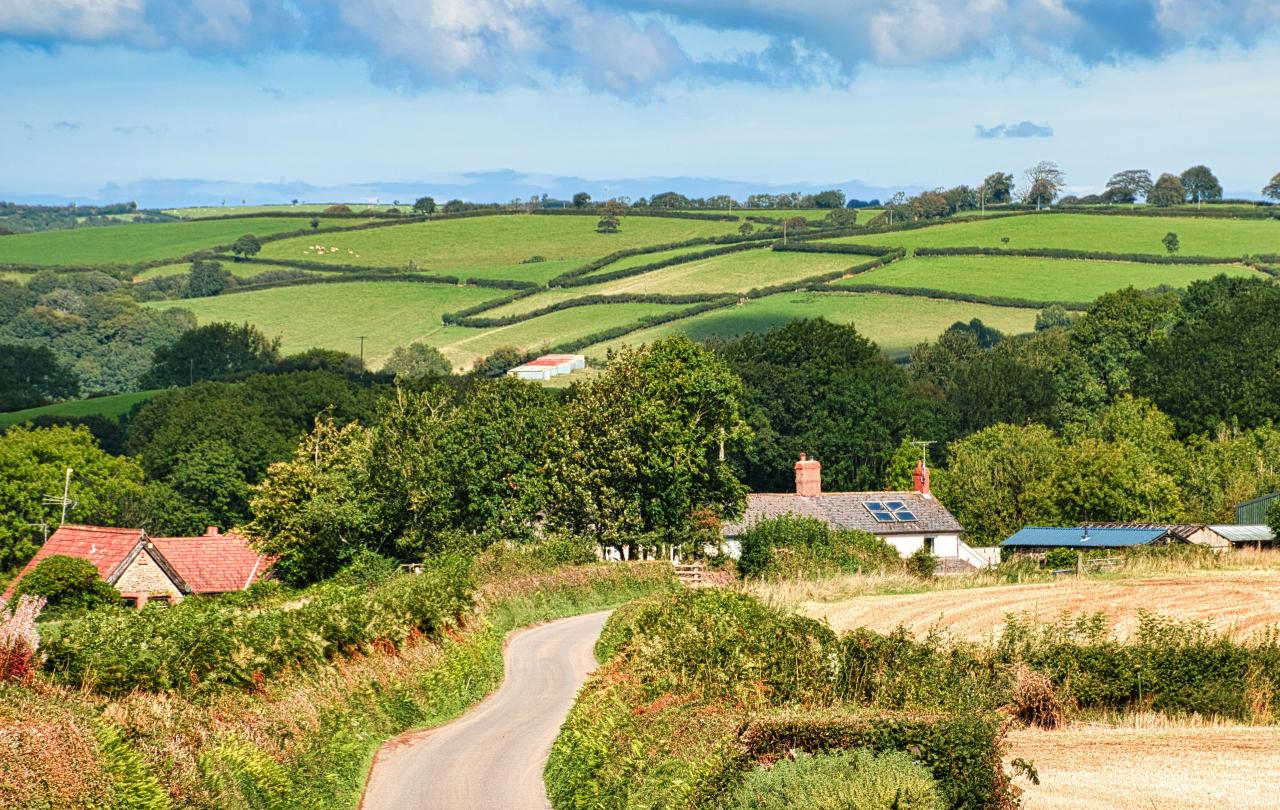
In May and June, the Devon hedgerows that hold the landscape outside my window are at their fullest, most colourful state of being. Walking the narrow lane that runs away from our house means walking between high hedgerows that rise like soft green walls either side, which really, means walking between ancient living things, because these hedgerows are old. Devon has some of the oldest hedgerows in the country, and so the world – older than the Parish churches whose towers I can see to the south, east, and west, which rise like old-growth trees out of a blanket of green fields.
Early Bronze Age farmers had to clear woodland to make their fields, and sometimes they left strips of woodland to mark boundaries. These are our oldest hedgerows. They are often found on parish boundary lines, and can support over 2,000 species, also acting as important wildlife corridors for many of them. To roughly date a hedgerow, you count the number of species in a 30m stretch – one species equals 100 years. I have taken to counting random 30m stretches of the hedges that line the lanes near us, and have concluded that we are surrounded by hundreds, in places thousands of years of history – of braided hawthorn and blackthorn, hazel and oak, pink campion and bluebell whose bulbs hide in ancient earth banks that many of the hedgerows sit on.
Now, in these spring hedges, hawthorn is in blossom, nettles overflow with prickly exuberance, and somewhere deep in the tangle a blackbird tunes its song. The hedges are thick with memory stitched together from centuries of hand-laying, stock-keeping, quiet watching. They are Devon’s old boundaries, but they do not divide so much as abound. Life spills from them: wrens and mice, vetch and violet, and so many more things unseen. These are not just boundaries that mark where other things like fields and roads begin and end then; they are living spaces in their own right. They are pathways for diverse life, they are structures that hold home and shelter, food and safety, they are corridors that contain history and story. They are not just edges, they are the centres of whole lives and worlds.
Walking here one May morning, I find myself wondering about the lines we draw – between land and lane, but also between ‘us’ and ‘them’ – and whether these lines too might be porous like the hedgerows, which have lived for so long not through independence but through care and relationship.
The hedges speak paradoxes that I am confronted with every time I go for a walk – of division and abundance, of separateness and connection, of containment and invitation. Lately, I am sitting with these and am coming to understand a threshold that the world offers me: between independence and interdependence. But the truth is I’m not very good at interdependence. I have so often retreated behind the wall of my self-sufficiency, but I am trying to pull that wall down and replace it with a porous and lifegiving hedgerow.
We draw lines – around ourselves, and between people, nations, beliefs, social classes, politics. Sometimes these lines are for safety, sometimes for exclusion. But the hedgerows tell me that it is possible to hold a line and also to let light and life flow through it and shape it. They tell me that these lines are not end points but invitations to communion.
In The Left Hand of Darkness, Ursula Le Guin wrote:
“…I know people, I know towns, farms, hills and rivers and rocks, I know how the sun at sunset in autumn falls on the side of a certain plowland in the hills; but what is the sense of giving a boundary to all that, of giving it a name and ceasing to love where the name ceases to apply? What is love of one's country; is it hate of one's uncountry?”
Le Guin’s work of science fiction is about otherness and connectedness, with different species having to learn empathy in order to collaborate and communicate. The darker the events in the book, the brighter the hope and relationship. The book feels like it was written for now, for this world.
On my hedge-edged walks I am in the presence of lives so unlike mine – plants, creatures, the people who have tended and cared for these hedges through generations.
In a world whose people are persecuted, othered, tired, it is easy to believe that the way of things is division and separation. But hedgerows suggest another way to live: layered, porous, complex and interconnected, creating space not just for encounter but for new life through that encounter. This is how I picture the Kingdom that Jesus speaks about and so often found solace in: a world of intermingling and ever-growing aliveness. I think Jesus would have walked with the hedgerows had he lived in Devon. I think he would have used them to speak of boundary-crossing between heaven and Earth, clean and unclean, Jew and Gentile. I think he would have pointed to them and said, see the tangled beauty of these? They are what the Kingdom is like: held and open, living and lifegiving. This is what I want our future to be too.
As I walk these old lanes, I am deepening into my hedgerow apprenticeship. I am learning to sink my roots in, to tend boundaries with care, to make space for life. I am also finding that there is nothing in the hedgerows that speaks of self-sufficiency. These ancient, interwoven green features that have defined this landscape are here because of relationships between species. It is easy to talk about the interconnectedness of everything, it is another thing to try to live it – to live like gifts, reciprocity, community, are things that might take the weight of our time. These old hedgerows give me a foothold though – they enliven the overused but hard-to-live idea of interconnection, they show me what it looks like and that it is an approach to life that is patient, strong, sustaining, real.
When I reach out my hand I can usually find something edible or beautiful in the hedgerow depending on the time of year: blackberry, hazel, oxeye daisy, pennywort, primrose. Yesterday, it was the cow parsley that really caught my attention: its frothing, foaming flourishing. In a few weeks it will give way to what comes next, just as it has always done, just as this world will always do. On my hedge-edged walks I am in the presence of lives so unlike mine – plants, creatures, the people who have tended and cared for these hedges through generations. I am also in the presence of relationship, and of hope.
Now, with so many crises bearing down on the world, and with anxiety and despair blooming, it is the hedges that remind me of other, older, wiser ways to be. It is the hedges that show me how to root deep into solid ground, and how to reach out to others, and to light, which are so often the same thing.
Support Seen & Unseen
Since Spring 2023, our readers have enjoyed over 1,000 articles. All for free.
This is made possible through the generosity of our amazing community of supporters.
If you enjoy Seen & Unseen, would you consider making a gift towards our work?
Do so by joining Behind The Seen. Alongside other benefits, you’ll receive an extra fortnightly email from me sharing my reading and reflections on the ideas that are shaping our times.
Graham Tomlin
Editor-in-Chief





